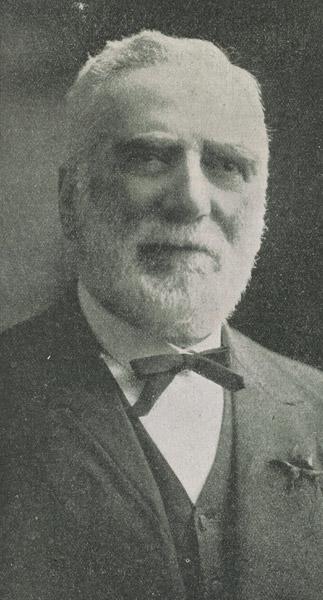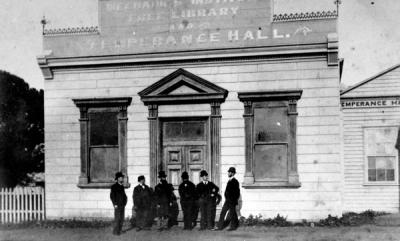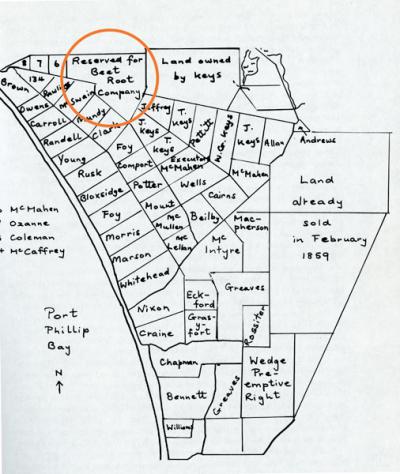Nathaniel Levi: Politician and Businessman
Nathaniel Levi was born on the twentieth of January 1830 in Liverpool, England, to Joseph and Sarah Levi. He travelled as a 24 year old to Melbourne on the Matilda Wattenback as a ‘first class cabin passenger’, arriving in Hobson’s Bay on 27 April 1854. On the voyage, Nathaniel kept a diary in which he described conditions experienced on the journey.
On leaving Liverpool on 4 December 1853 he wrote:
At half past twelve o’clock this day the anchor being weighed, and steam tug being attached by ropes to our ship, our first movements were made in progressing slowly up the River, saluting the fond old town of my birth with the booming of cannon from on board our ship. The cheers from the throngs on piers as we proceeded slowly along were re-echoed time after time by the passengers on board and rarely was a scene more exciting witnessed as we gallantly rode along bidding adieu for a time to those shores which were the possessors of the whole of my existence.1
Writing to his mother he said:
By the time you receive this we shall have made pretty good progress in one of the finest ships that ever left the Port of Liverpool. I have already made acquaintance with the elite of the cabin who are in reality first rate the cabin containing all my parcels …. You have no idea what a roomy place it is and there appears every prospect of having a famous voyage. Would you credit the mail consists of 75,000 papers and 33,000 letters …
On the eighth day of the voyage Levi was not feeling well. He wrote:
Can’t eat drink or sleep the pitching of the vessel from stern to bow is terrific and the rolling from side to side enough to shake you into pieces, got into my bed but vomit vomit. … At this time the wind was blowing a strong gale from west south west, the waves came dashing against each side of the ship with such a force that would have made one think she must be smashed to pieces … The fine ship Matilda Wattenback which sailed from Liverpool on the 4th December 1853 only eight days since, the pride of all who saw her departure now we’ve an altered look, with masts hanging over her sides and sails flapping about, nought else could be thought but they would drive through the sides of the ship and so fill her, but Heaven be praised there were those on board who had lived to see similar scenes and who were possessed of that coolness energy and self-control which tended to inspire confidence in the passengers.
The captain, J C Clare, decided to call in to Lisbon to arrange repairs to the dismasted ship but the arrival of the ship was not well received. It was quarantined and no one was permitted to land. The fear of the Portuguese authorities was that the ship could be bringing cholera to their country from England where there an epidemic of the disease was raging. Captain Clare and surgeon De Hayne signed a letter to the Portuguese authorities in which was listed the ship’s complement of 13 adults as cabin passengers, 37 intermediates (a lesser quality of accommodation) with 6 infants and 37 crew, all of whom were free of cholera and sickness. The ship’s captain also wrote to the British Ambassador at Lisbon seeking his support in gaining their liberty. Eventually the ship left Lisbon with incomplete repairs to the sails.
On the night of 26th April, the ship was only a short distance from the heads of Port Phillip Bay, but it was too dangerous to proceed further until daylight.
Up early in the morning Levi saw the coast line which he described it has having ‘a rugged appearance’. There were further delays of several days before entering Port Phillip because of the lack of a pilot to guide the ship to a safe anchorage in Hobson’s Bay. On arrival in Melbourne, Nathanial Levi wrote a letter to the captain of the ship praising his work and the work of his crew in bringing the ship safely to the passengers’ destination.
Following disembarkation from the Matilda Wattenback, Nathaniel Levi found himself in a prosperous boom town experiencing a flood of immigrants wanting to try their luck in finding gold. By 1858 he had joined the firm of John Levey & Son who had general stores in Melbourne and Maryborough. While in Maryborough, he stood as a candidate for the Victorian Legislative Assembly, the lower house in the parliament, but he failed by fourteen votes to be elected. In 1860 he was successful, becoming the first Jew elected to the Victorian Legislative Assembly, holding that position for five years before successfully standing as a candidate for the seat of East Melbourne which he held until 1868. After that time, he made several unsuccessful attempts to regain a place in the Lower House. But in 1892, twenty four years later, he was an elected member of the Legislative Council (the Upper House) for North Yarra Province. He retained that position until 1904 when he lost the seat due to a redistribution of electoral boundaries.2
As a person wanting to be elected to parliament or as a politician he visited various towns and spoke on the issues of the day that concerned him. At these meetings he advocated ‘one man one vote’ for elections to the Legislative Council, for limited Sunday opening of hotels, and opening of public libraries on Sundays. He considered it ’tyrannical to compel a man to shut his shop at a certain hour when no one but himself was affected’. He approved of the construction of two railway lines to the northern suburbs and of the existing Education Act. Moreover, he believed his views were more in accord with the views of the working classes than any of his opponents standing for election. He considered Federation would come, but not so quickly as some seemed to think. He spoke about the importance of local industries and the need to protect them from competition of other colonies or countries.3
At the Mechanics’ Institute in Cheltenham in 1886 he spoke in support of the abolition of the gold duty, liberalisation of land laws, and argued the value of the Torrens Act which was intended to simplify the process of transferring land titles. He saw the importance of developing the Cape Patterson coal fields, and introducing a much heavier poll tax on Chinese. He said he would use his influence to increase the number of trains on the Mordialloc line, a proposal that received strong support from local residents. Similar support, no doubt, resulted from his idea that members of the Legislative Council should not be paid anything. At the conclusion of the Cheltenham meeting the audience passed a unanimous vote of confidence in Nathaniel Levi, carrying it with acclamation.4
Beside his role as a politician, Nathaniel Levi was active in business. In 1864 he started a distillery at Footscray where he successfully produced pure spirit and sugar from sugar beet. The quality of his product was recognised internationally with the award of medals.5 A few years later he was seeking public support for a government grant of 10,840 acres of land on the Carrum Swamp where he would grow sugar beet, build a distillery, drain the swamp, supply the district with fresh water, and employ at least 1500 local people.6 At a Mordialloc meeting, a petition favouring Mr Levi’s request of a government grant was signed by 258 farmers and others residing in Mordialloc. A noisy meeting of residents of Mordialloc and Moorabbin was held a week later to consider Mr Levi’s proposal. The meeting decided, by a very large majority, to support the application.7 There were, however, people who disagreed. Mr Beilby, although he didn’t attend the meeting, objected to the lease being granted and Mr W Lockhart Morton had put forward a counter claim for a grant which failed to get local support.8 The Argus reporter was critical of the Levi proposal. He wrote:
The applicant, Mr Levi, is not content to ask for the Carrum Swamp in the usual businesslike manner, but makes a kind of public question of his application, and proceeds by deputation and public meeting as if, instead of being a mere private speculator, he were a propagandist of industrial progress, with the special mission to instruct the inhabitants of Mordialloc and Moorabbin in the mysteries of growing sugar beet… the deputation and the petition, and the resolutions adopted at the Cheltenham meeting, should not be permitted to have the slightest weight in determining the fate of his application. … If the swamp is to be leased at all the best plan would be to put it up to auction.9
In 1906, the government was encouraging market gardeners to grow sugar beet. Informal discussions between government representatives and gardeners occurred at the Moorabbin Show held at Mentone that November. Mr F E Lees from the Department of Agriculture was in charge of discussions, but it was believed he only had a small chance of enlisting local market gardeners to take up the sugar beet proposal. While Lees pointed out the financial benefits of growing sugar beet at meetings at Dandenong, Cheltenham, and later Brighton, he failed to convince his audiences. They saw their practice of growing horse carrots, ‘a very remunerative industry’, at least as equal in financial returns to that from growing sugar beet.10
The ‘dream’ of Nathaniel Levi to drain the Carrum Swamp, establish a sugar beet industry, and employ a large number of workers did not eventuate. He died on 11 September 1908 at his residence ‘Liverpool’ in Princes Street, St Kilda. He was 78 years of age.
During the time he lived in Melbourne, Levi contributed as a politician in both Houses of Parliament, he founded the Chamber of Manufactures, served as president of the Melbourne Hebrew Congregation on several occasions, and as head of the Zionists Board as well as the Board of Jewish Education. He was accurately described by L E Fredman, as a strong willed, energetic and orthodox Jew.11 He was a contributor. His remains were interred in the Jewish portion of the Melbourne Cemetery. The funeral cortege was three quarters of a mile in length, and two or three hundred more mourners were at the cemetery.12
- 1. Nathaniel Levi, Diary, 1853 December 7 – 1854 April 27 [manuscript].
- 2. The Herald, 11 September 1908, page 6.
- 3. Fitzroy City Press, 24 July 1891.
- 4. The Age, 2 September 1886.
- 5. Williamstown Chronicle, 25 July 1891.
- 6. The Argus, 29 January 1869.
- 7. The Argus, 5 February 1869.
- 8. The Argus, 6 February 1869.
- 9. The Argus, 6 February 1869.
- 10. The Age, November 1906.
- 11. Fredman, L E. “Levi, Nathaniel (1830-1908)” Australian Dictionary of Biography Volume 5, 1974.
- 12. Malvern Standard, 19 September 1908, page 3.




